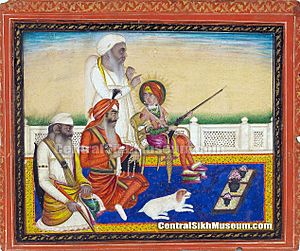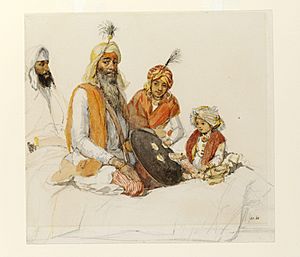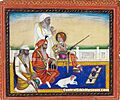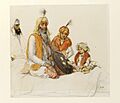Tej Singh facts for kids
Quick facts for kids
Raja
Tej Singh
|
|
|---|---|
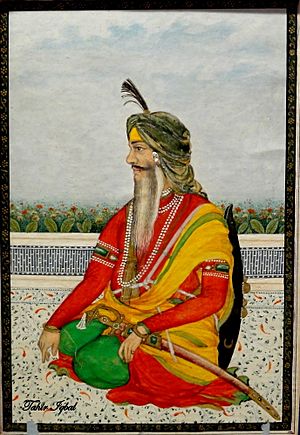
Miniature painting of a seated Raja Tej Singh with a sword on his lap and shield on his back
|
|
| Birth name | Tej Ram |
| Born | 1799 |
| Died | 4 December 1862 |
| Rank | General |
| Commands held | Diwan of Peshawar |
| Children | Narinder Singh |
| Relations | Misr Niddha (father) Harbans Singh (brother) |
Tej Singh (born in 1799, died on December 4, 1862), also known as Raja Teja Singh, was an important Sikh military leader. He served in the Sikh Empire. He became the Commander-in-Chief of the Sikh Khalsa Army during the First Anglo-Sikh War.
Contents
Tej Singh's Life Story
Early Years
Tej Singh was born in 1799. His birth name was Tej Ram. He came from a Gaur Brahmin family. His father, Misr Niddha, was also a commander in the Sikh Khalsa Army.
Tej Singh started working at the Lahore Durbar, which was the Sikh court, in 1812. In 1816, he took part in the Pahul ceremony. This is a special Sikh ceremony, and after it, he was given the new name Tej Singh.
Military Career and Leadership
Tej Singh proved himself to be a brave soldier. He fought in battles in Kashmir in 1813, 1814, and 1819. He also took part in operations against Mankera, Leiah, and Derajat. Because of his skills, he was made a general in the Sikh army in 1818.
In 1823, he was the leader of an operation in Peshawar. He also fought in the Battle of Teri during this time. By 1831, he was in charge of twenty-two groups of soldiers in the Sikh army. In 1839, he helped with a joint invasion of Afghanistan. He was based in Peshawar during this campaign.
Challenges and Decisions
After Maharaja Ranjit Singh died, things became complicated in the Sikh court. Different leaders had different ideas and goals. Tej Singh had a lot of influence over Nau Nihal Singh. He supported Chand Kaur becoming regent after Nau Nihal Singh's early death.
Tej Singh seemed to be loyal to Raja Gulab Singh of Jammu. Both of them thought it was a mistake to fight against the British. However, Rani Jindan, who was ruling for the young prince Duleep Singh, ordered Tej Singh to lead the troops against the British. He did so, but he was not happy about it.
Some historians, like Harbans Singh, have written that Tej Singh's actions during the Anglo-Sikh Wars were confusing. They suggest he might have had secret talks with the British. For example, during the First Anglo-Sikh War, two Sikh army groups under his command were near Firozpur. They could have easily defeated the small British army there. However, Tej Singh never gave the order to attack.
Another example is during the Battle of Ferozeshah, which happened on December 21–22, 1845. The army he commanded had good chances to win against the British. But he ordered his soldiers to stop fighting when the British were in a weak position. He then left the battlefield and went to Lahore.
In the Battle of Sobraon on February 10, 1846, General Tej Singh crossed a bridge over the Sutlej river. He then ordered the bridge to be destroyed. This action made it very hard for the Sikh army to retreat. Some historians believe this led to the Sikh Army's defeat. Tej Singh also left the battle with Lal Singh, even though the fight was still going on. He told another leader, Sham Singh Attariwala, to do the same, but Sham Singh refused and fought until the end. As he retreated, Tej Singh ordered his troops to destroy boats and a bridgehead. This made it even harder for the Sikh forces to escape safely.
After the Sikhs lost the war, the Treaty of Lahore was signed. This agreement meant that Kashmir was sold to Gulab Singh to help pay the British for the war. It also changed how the Sikh army was organized.
Later Life and Honors
After the Sikh Empire ended in 1849, Tej Singh received special benefits from the British. He kept all the "rights and privileges" he had during the Sikh Empire's rule. He was given the power of a magistrate in his lands. He also received a high position to manage the Golden Temple complex in Amritsar.
Tej Singh supported the British during the Sepoy Mutiny of 1857. He sent cavalry troops to help them. Because of his support, he was given the title of Raja of Batala. He died on December 4, 1862. His adopted son, Harbans Singh (who was actually his brother), took over after him. Tej Singh also had a biological son named Narindar Singh.
Images for kids


